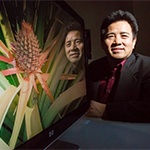Bioresearchers have long been studying the nuances of photosynthesis in an effort to improve an already excellent recipe laid down by nature. In recent experience, we have witnessed efforts to increase the efficiency of photosynthesis at Washington University in St. Louis and to increase the productivity of photosynthesis at the University of Illinois, Urbana-Champaign. Another research group at UIUC is now searching for a way to protect photosynthesizing plants from increasing drought rates.
 Plant biology professor Ray Ming believes the first step to solving this problem is to realize that it is a redundant problem. Several plants survive and even thrive in regions undergoing nearly constant drought. Cacti are a prime example of this. So Ming hypothesized that examining the genome of such drought-resistant plants could shed light on a possible method to save prime crops from impending heat waves.
Plant biology professor Ray Ming believes the first step to solving this problem is to realize that it is a redundant problem. Several plants survive and even thrive in regions undergoing nearly constant drought. Cacti are a prime example of this. So Ming hypothesized that examining the genome of such drought-resistant plants could shed light on a possible method to save prime crops from impending heat waves.
Dr. Ming and his group found a promising candidate in pineapple.
"Our analysis indicates that the pineapple genome has one fewer whole genome duplication than the grasses that share an ancestor with pineapple, making pineapple the best comparison group for the study of cereal crop genomes," says Ming in a UIUC press release earlier this month. Pineapple survives hot days and is genetically similar to important crops like soy and rice.
So the question that remained was, how is pineapple drought-resistant? The answer lies in the type of photosynthesis it uses. Most crop plants use a type of photosynthesis called C3, while pineapple uses a type of photosynthesis known as CAM.
"CAM plants use only 20 percent of the water used by typical C3 crop plants, and CAM plants can grow in dry, marginal lands that are unsuited for most crop plants," explains Ming. The secret behind the success of CAM is that it utilizes a circadian clock, closing the pores of the leaves during the day and opening them at night. The result is that CAM plants can gain less water from the environment during the day, but they also lose less. In a dry environment where a plant isn’t getting much, if any, water during the day, this is extremely effective in preventing said plant from becoming parched in the heat.
The next step for the group is to produce a classically C3 crop that instead utilizes CAM photosynthesis. The National Science Foundation, the U.S. National Institutes of Health and the U.S. Department of Energy supported this work. More funding information related to the University of Illinois, Urbana-Champaign and the research it conducts can be found using the link below:
If you are a UIUC researcher or laboratory supplier, and would like to boost awareness of your products and increase scientific sales, plan to attend Biotechnology Calendar, Inc.'s annual Urbana-Champaign BioResearch Product Faire™, currently scheduled for April 12, 2016 on the University of Illinois campus. Later on, at the end of the summer, we'll have our Chicago BioResearch Product Faire™ on September 22, 2016. Biotechnology Calendar, Inc. has been bringing life science research trade shows to top research campuses for 20 years now. If you’d like to attend a show closer to home, please see our 2015 schedule of events or our brand new 2016 schedule of events.


